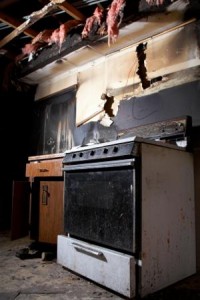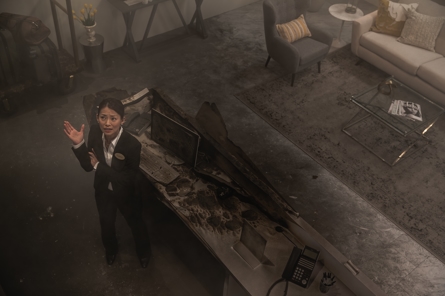 Smoke damage and soot damage are usually the result of a house or building fire. However, this damage can also occur from a fireplace or wood stove. No matter what the cause of the smoke and soot damage, cleaning the area can be a difficult task. Fire and smoke leave behind an oily residue–also known as soot–that normal cleaning usually does not remove. The soot can stain a variety of surfaces, including walls, flooring and fabric. The quicker you deal with smoke and soot damage, the higher the chance of restoring the item. Even when the fire is out, the damage continues. Much of the material found in furniture and flooring is synthetic. When burned, synthetics create a variety of complex chemical reactions. After only a few days, these items go from cleanable to unsalvageable.
Smoke damage and soot damage are usually the result of a house or building fire. However, this damage can also occur from a fireplace or wood stove. No matter what the cause of the smoke and soot damage, cleaning the area can be a difficult task. Fire and smoke leave behind an oily residue–also known as soot–that normal cleaning usually does not remove. The soot can stain a variety of surfaces, including walls, flooring and fabric. The quicker you deal with smoke and soot damage, the higher the chance of restoring the item. Even when the fire is out, the damage continues. Much of the material found in furniture and flooring is synthetic. When burned, synthetics create a variety of complex chemical reactions. After only a few days, these items go from cleanable to unsalvageable.
ServiceMaster of Salem are experts in understanding the chemical combinations that can effectively clean and salvage your belongings. We can even remove soot from at-risk items such as brass, aluminum, chrome, marble, tile, and porcelain as well as upholstery and carpets, thus helping to avoid additional expenses.
We use the latest equipment and supplies in our five step fire and smoke restoration process:
- Emergency pre-cleaning
- Content cleaning
- Content pack-out
- Wall and ceiling cleaning
- Deodorization
What to do if you have smoke/fire damage
- Blow off or brush vacuum loose soot particles from upholstery, drapes and carpets.
- Cover carpeted traffic areas with towels or old linens to prevent additional soiling.
- Discard open food packages. The food could be contaminated.
- If electrical service is off, clean out your freezer and refrigerator. Leave the doors propped open or place charcoal in the unit.
- Send clothing with heavy smoke damage to a qualified professional dry cleaner that specializes in smoke damage.
- Clean Formica and chrome fixtures in the kitchen and bathroom to prevent permanent tarnishing.
- Wipe residue from porcelain bath fixtures to prevent etching.
- Wipe the leaves of houseplants to remove smoke residue.
- Change the air filter on your furnace if it uses forced hot air.
- Tape cheesecloth over intake and outlet air registers to capture any loose soot in the air. This is even more effective if the cheesecloth is damp.
- If the outside temperature is above 60 degrees, air out the house to reduce smoke odor.
Important warning signs on smoke and fire damage
- Do not attempt to wash any papered or flat painted walls without consulting your professional cleaner. Incorrect cleaning procedures could compound the soot residue problem.
- Do not attempt to clean carpets or upholstered furniture. Incorrect procedures could increase damage.
- Do not use electrical appliances that have been close to fire or water before having them checked.
- Never use ceiling fixtures if the ceiling is wet. A short circuit could result.
- Do not touch anything. Soot on your hands can permeate upholstery, walls and woodwork, causing further damage.
- Do not eat food that has been exposed to fire or smoke.
- Do not wait to call for professional help.


